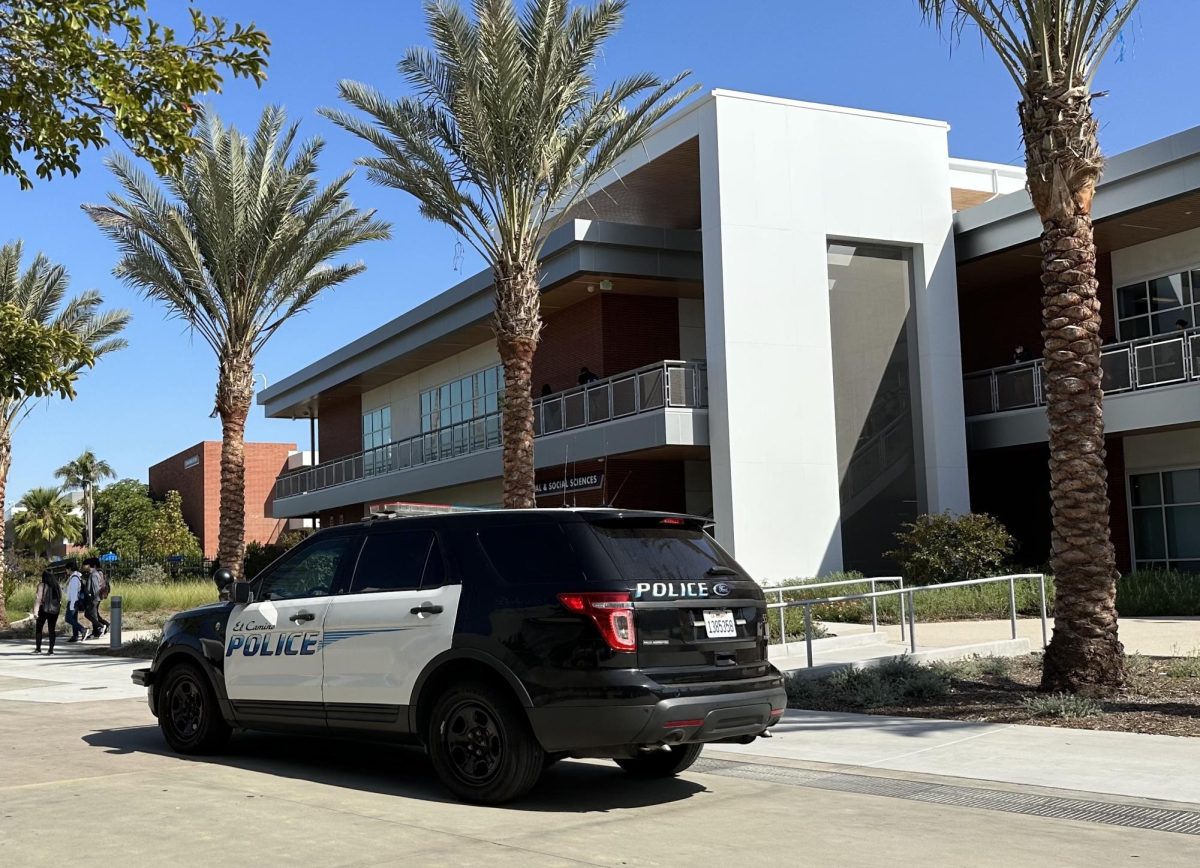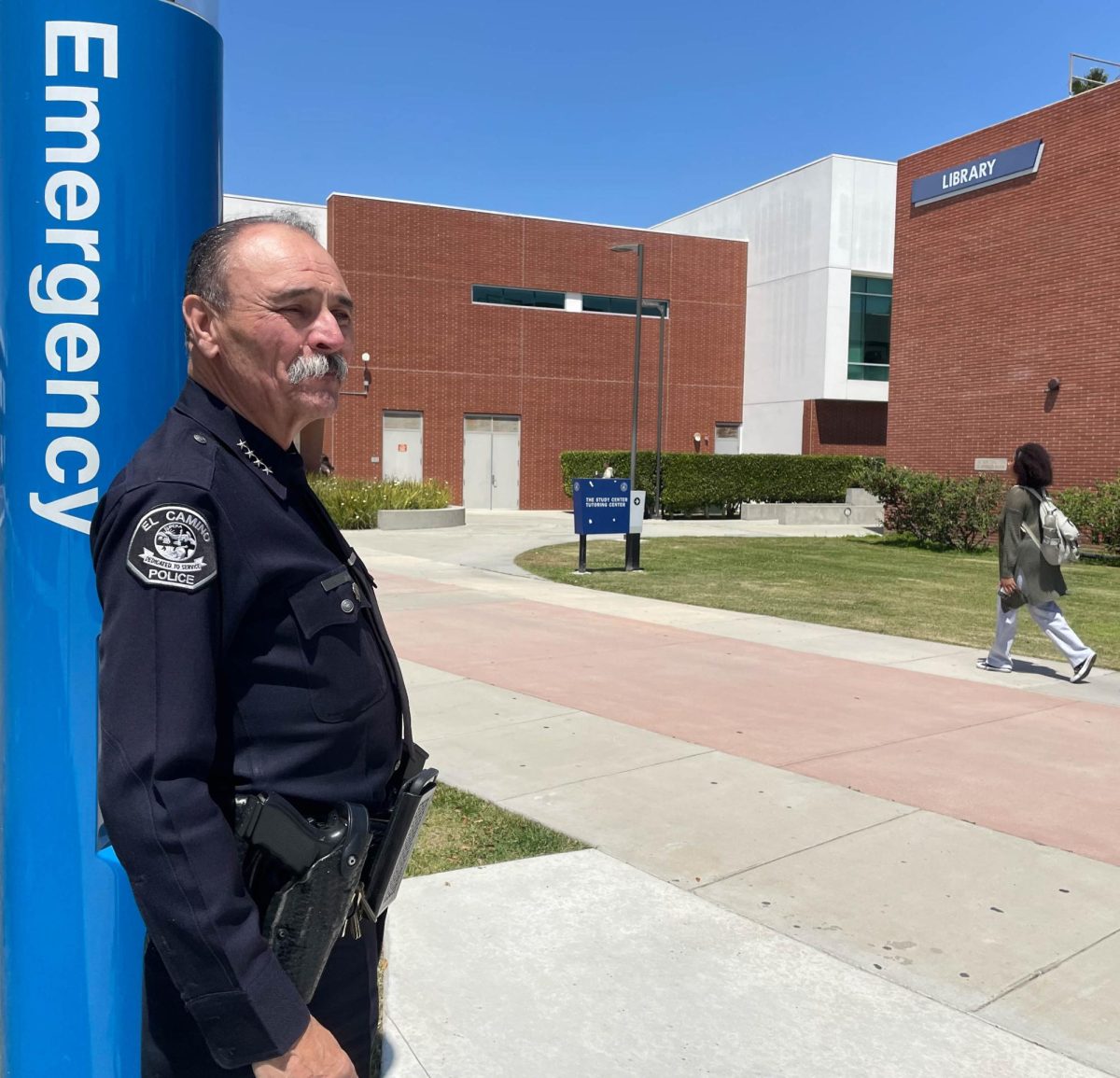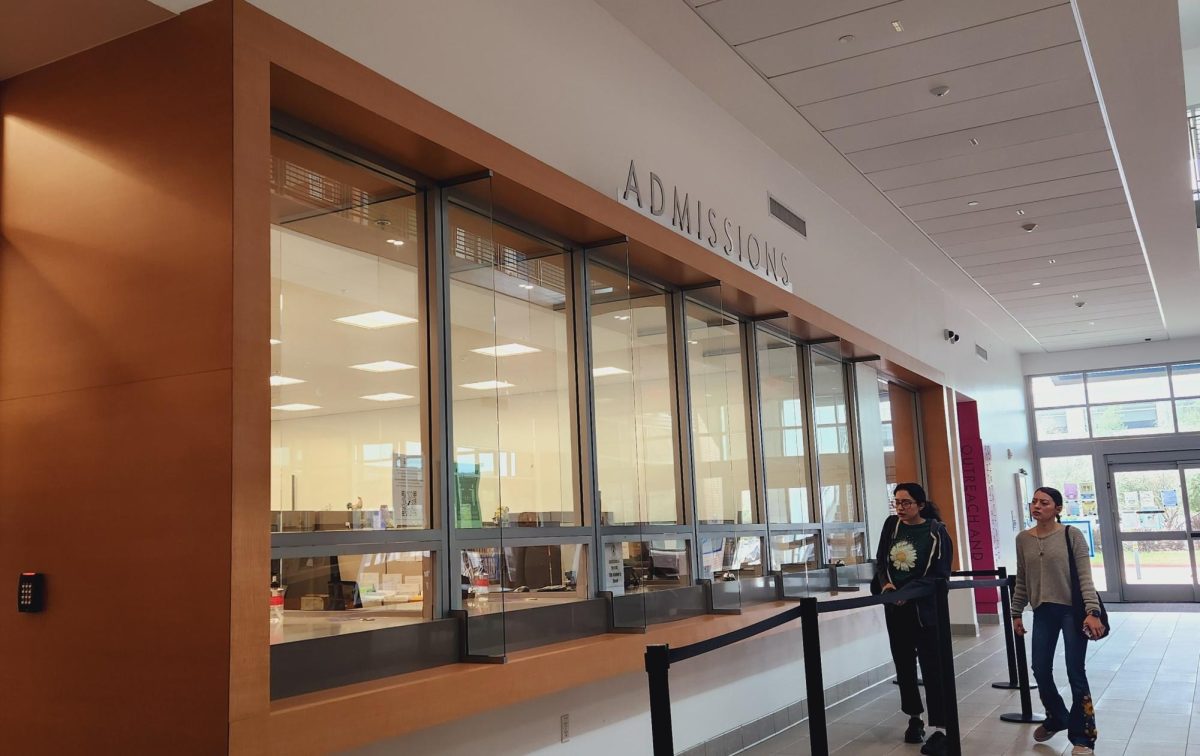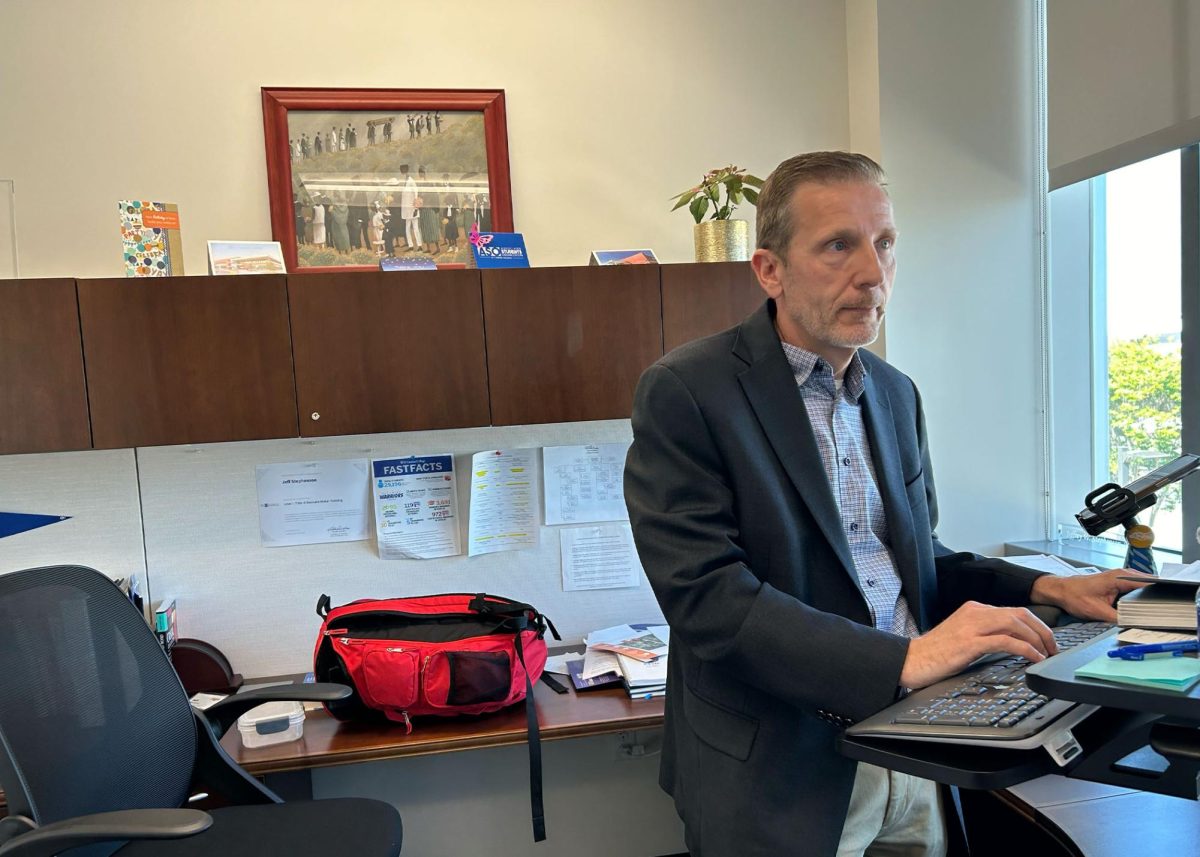El Camino College could start collecting parking fees from students in 2024 as part of its moneymaking strategy to address a possible bankruptcy.
Other changes in student fees are on the table; a $24 per unit increase in non-resident tuition fees was already approved by the Board of Trustees in March.
El Camino is facing a $20 million deficit for July 2023 to June 2025 and another $20 million from July 2025 to June 2026.
This is according to El Camino President Brenda Thames’ April 29 letter addressed to the campus community.
The deficit has resulted in a series of cuts including cancellation of 37 employee positions, a potential hiring freeze and reducing faculty sabbaticals.
A “review of extra-curricular programs” including athletics, debate, forensics and journalism is also being considered.
Other cuts that would be “worst case scenario” include furlough days, reducing class schedules and salary reductions.
Thames sent the letter to students, faculty and staff days after Vice President of Administrative Services Robert Suppelsa gave an update on the three-year financial projection of the college in a budget town hall on April 26.
In the first budget town hall on Feb. 16, he said El Camino has been spending more than it has been earning for the past 10 years.
In an interview with The Union, two college vice presidents did not categorically deny that there was mismanagement of district funds, a persistent concern among members of the campus community.
For fiscal year 2023-24, the college’s projected expenditure, or the amount it planned to spend, was $192.12 million, but the revenue it expected to generate was only $172.18 million.
This means the college would have to take the $19.94 million deficit out of its beginning fund balance of $58.70 million.
If the trend continues and no belt-tightening measures are put in place, the college will have a balance of $17.96 million in fiscal year 2025-26.
This scenario would violate the district’s agreement with the California Community Colleges Chancellor’s Office, which calls for El Camino to have an emergency fund reserve of at least $34 million.
By 2026-27, the college will have a negative fund balance of $6.34 million if the crisis is not averted, Suppelsa said.
“We are essentially bankrupt at that point,” Suppelsa said in the meeting.
The Union has made several attempts to schedule an interview with Suppelsa for follow up questions regarding the budget but he has not agreed to an in-person or phone interview because he said he wants the questions in advance. This is against The Union’s interview policy.
The Fiscal Crisis and Management Assistance Team would then take over the financial decision for the district, he said.
“So we would be under essentially state receivership if we had stayed on exactly the same path,” Suppelsa said.
To address the budget crisis, the college looked for ways to limit spending. After finding $7 million to cut, the college designated the task of finding an additional $13 million to the Budget Leadership Strategies Team, a committee of 16 people who represent students, faculty, classified staff and police. They began meeting in December 2023 to propose suggestions about where the money should be cut.
The committee has identified 11 initial strategies estimated to save around $18.8 million.
There are four categories of what will be cut: items already in discussion, items that may be “inconvenient” but seem reasonable, items that “might be difficult” and items that are the worst-case scenario.
Some of the items that have already been implemented or are planned to be implemented are reducing sabbaticals from 12 to 4 for 2024-2025, reducing faculty recruitments for computer science, sign language and theater, reducing “unplanned/uncommitted nonessential travel” and delaying a “2% salary increase for management/supervision.”
The second category, which consists of “potentially inconvenient” items, includes elimination of the EASE program which is a mental health program for employees, reducing “spending on outside vendors, professional experts and other outsourced work,” reviewing energy costs, reducing Center for the Arts schedule, eliminating an in-person graduation ceremony and restricting non-essential travel.
The third category of “items that might be difficult” includes a retirement incentive for 2024-25, discontinuing low-enrolled programs and reviewing extra-curricular programs including athletics, debate, forensics and journalism.
The last category of items that are “worst-case scenario” include furlough days, temporary salary reductions and reducing class schedules. For this category, Suppelsa said, “There are no current thoughts that says we have to actually realize any of these savings.”
There will also be more strategies implemented to generate revenue, including increasing facilities rentals.
Why is the college in a deficit?
El Camino is facing a $20 million budget deficit this year due to a combination of factors.
Vice President of Academic Affairs Carlos Lopez said the three main reasons are the current state budget, the fact that the college is no longer under emergency conditions funding and the approval of new labor agreements with the district’s labor unions.
California has a budget deficit of over $30 billion for 2023-24. In January, Governor Gavin Newsom released the state’s 2024-25 budget proposal. It projected a $38 billion shortfall.
Erik Saucedo, a senior policy analyst at the California Budget & Policy Center, a budget research and analysis nonprofit, said although the state is constitutionally required to guarantee minimum funding to community colleges under Proposition 98, they are still impacted by the state’s budget deficit.
“So when the revenues that go into that big pot of funding, decrease, the portion that goes to schools and community colleges also decreases,” Saucedo said. “So that’s exactly what’s happening right now, when we’re looking at the budget, there’s less revenue than we thought, and things aren’t looking good. So that means there’s gonna be less available for schools and community colleges.”
Suppelsa reiterated in both town hall meetings that the college would still be in the same situation “regardless of the recent or future state financial shortfalls for education spending.”
The approval of new labor agreements with the district’s primary labor unions also contributed to the current situation, Lopez said. There were significant costs associated with those changes, he said.
President of the Federation of Teachers Kelsey Iino said there has been uncertainty and lack of clarity regarding the reasons as to why the budget cuts are happening.
“I think there’s some suggestion that [salary] increases are part of the problem. But if other colleges have been able to have these, you know, salaries and benefits, for a decade, then, there must be mismanagement of spending elsewhere,” she said.
The Union asked Lopez and Vice President of Student Services Jeff Stephenson, who was present during the May 6 interview, about community concerns that the district administration has mismanaged the budget.
“Since I don’t control the overall college budget, I don’t know that we can comment on that. I can tell you that we work hard not to mismanage any funds at Academic Affairs,” Lopez said.
Lopez said when they find errors on the budget, they clean them up. “But I don’t represent the entire college with regard to that kind of question. So I can’t really answer it directly,” Lopez said.
Stephenson echoed Lopez’s statement. “I think our tenure here both have been pretty short, but what we are doing is just trying to clean up, trying to catch any errors or anything like that,” Stephenson said.
The “budget cleanup” they referred to is the cancellation of 37 positions. Lopez said that in the Office of Academic Affairs, a number of the positions that were removed were not actually open positions. Rather, they were positions that had still been receiving funding but there was nobody in them and his office wasn’t going to recruit them.
Budget cuts raise concern on campus
Several faculty and staff are concerned about the budget cuts.
As president of the Federation, Iino fought for more sabbaticals and salary raises. One of the Federation’s “biggest wins,” after over a year of negotiations, was an increase of sabbaticals from eight to 12.
Iino said because of the high number of faculty on campus, “unless you increase the number [of sabbaticals], some faculty will never have the opportunity to do their research and have their sabbatical.”
Now, due to the budget crisis, sabbaticals will be cut from 12 to four.
“We didn’t quite understand initially, when the district made a decision to cut that to four. We feel like…to keep it at eight would have felt more fair. But to cut it to [four], felt pretty sad,” she said.
Iino said there have been talks of furlough days and layoffs, although she believes the situation is not “that dire yet.”
“I’m very invested in this college, and so I think my game plan is to focus on how we can increase funding,” she said. “To be able to invest my time in the quality and longevity of our institution is my focal point…and to protect the vulnerable faculty…and my classified colleagues.”
Darcie McClelland, Academic Senate vice president of educational policies has been at the college since 2016. She said the college has been prepared for this deficit since state funding changed around 2018 and enrollment started declining.
Aside from looking where to cut wasteful spending, the college is “aggressively pursuing increasing enrollment” and also grant funding, she said.
El Camino has seen about a 20% decrease in average enrollment from 2017 to 2023.
“We’re doing everything we can to increase enrollment, including things like building up noncredit [classes], building up dual enrollment–like other nontraditional sources of enrollment that have not been big things for the college in the past we’re considering in a much larger way now,” McClelland said.
Student success coach Fernando Valtierra said he feels “left in the dark.”
His contract was supposed to end June 30, but now it will end June 15. If employees want to work until June 30, he said, there are limited spaces available to work those last two weeks.
As he is doing his master’s program, Valtierra was hoping to come back to work at El Camino once he finished the program.
Now that less positions will be available, he said, it will be harder for him to return.
“It’s disheartening, knowing I possibly don’t have a future,” he said.
Valtierra also said he feels like the college is not being transparent.
“Things are just being done behind closed doors, so we’re kind of just left in the dark,” he said.
Russell Serr, dean of health sciences and athletics, said the Athletics Department is trying to cut on travel expenses and instructional supplies, encouraging members in the department to request what they need, “not necessarily what they want.”
Serr said he thought it was normal to have athletics as a line item for potential review, considering it is a big department that requires “quite a bit of budget.”
“The biggest concern I have…is the unknown,” he said. “I don’t think anybody knows how much we’ll have to cut or if we will have to cut…I’m just confident that the college can make the cuts that they need to…and still be able to serve students.”
Professor of Communication Studies and Director of Forensics Francesca Bishop said she was asked by Christina Gold, the dean of Behavioral and Social Sciences, to cut 40% of the forensics budget.
This will affect the number of students admitted to the forensics program and the number of students that will attend tournaments.
“It makes me sad that less students are going to have that opportunity, especially since the vast majority of our students are from minorities and low-income,” she said.
Usually the program starts with 24 students. Now, it will start with 18 this fall, Bishop said.
“I just wish the cuts could have come in places that wouldn’t impact undeserved-community students,” she said. “It just seems a shame when we’re trying so hard for equity, to cut programs we know benefit underserved students.”















![A United Airlines jet takes off from Los Angeles International Airport on May 15. From Jul. 15 to Aug. 4, El Camino students will study in Madrid, Spain. “Once students understand the little elements [of Spanish culture] that are different, they start to appreciate Spanish culture,” Study Abroad Program Director Xocoyotzin Herrera said about the effects studying abroad has on students. (Raphael Richardson | The Union)](https://eccunion.com/wp-content/uploads/2024/06/J8-KATIE-1-1200x800.png)
